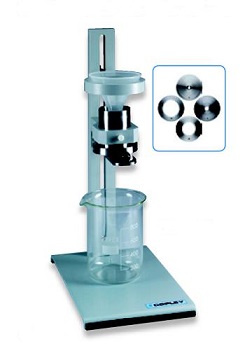PCATALOG
Powder Flowability
Flow through an Orifice 
Measuring the ability and the time taken for a powder to flow through an orifice of known size is a useful method of quantifying powder flow.
The cylinder attachment comprises a stainless steel cylinder having a capacity of 200 mL and comes complete with a set of 20 interchangeable stainless steel disks (each having a precision drilled hole in the centre covering the following sizes: 4, 5, 6, 7, 8, 9, 10, 12, 14, 16, 18, 20, 22, 24, 26, 28, 30, 32, 34 and 36 mm) each of which can be secured to the bottom of the cylinder by means of a collar provided for this purpose.
The cylinder attachment can be used in two ways (a) to carry out quantitative flowability tests based onmass vs time or (b) to determine the intrinsic flowability of the powder concerned in the form of a flowability index based on comparative measurements.
In certain circumstances where, for example, the purpose of the test is to simulate flow in a hopper or other production situation, it may be preferable to use a funnel in the form of a truncated cone as opposed to a cylinder.
For comprehensive product details, specifications and part numbers, please request a copy of our brochure “Quality Solutions for the Testing of Pharmaceuticals”.
Angle of Repose 
The angle of repose is the angle (relative to the horizontal base) of the conical pile produced when a granular material is poured on to a horizontal surface. It is related to the density, surface area and coefficient of friction of the material concerned.
The angle of repose attachment comprises a 100 mm diameter circular test platform together with a digital height gauge having a range of 0-300 mm.
For this particular test, the funnel is normally equipped with a special 10 mm i.d. nozzle mounted 75 mm above the test platform. If necessary, the contents may be stirred to assist in the powder flow.
The angle of repose can be determined by reading off the height of the powder cone in mm from the digital display of the height gauge and dividing the reading by 50.
For comprehensive product details, specifications and part numbers, please request a copy of our brochure “Quality Solutions for the Testing of Pharmaceuticals”.
Shear Cell
Shear cell methodology is widely used in the pharmaceutical industry to determine the flow properties of fine grained powders and bulk solids and how they will behave in bins, hoppers, feeders and other handling equipment.
The test is based on measuring the force required to shear a circular disk through a prepared sample of bulk material. The sample is first subjected to a consolidated load such that the bulk density of the material can be determined – ideally, this should be similar to the loads experienced by the material in practice.
The acrylic disk sealing the bottom of the test cell is now removed and load steadily applied to the test sample by pouring sand thought a funnel into a container of appropriate proportions until such time as the sample fails (shears).
The results are expressed in terms of bulk density, shear strength and , if appropriate, estimate of the device outlet required.
For comprehensive product details, specifications and part numbers, please request a copy of our brochure “Quality Solutions for the Testing of Pharmaceuticals”.


 Print
Print Consultation:010-66155031/32/33
Consultation:010-66155031/32/33 Email:office@goodwill-tech.com
Email:office@goodwill-tech.com
